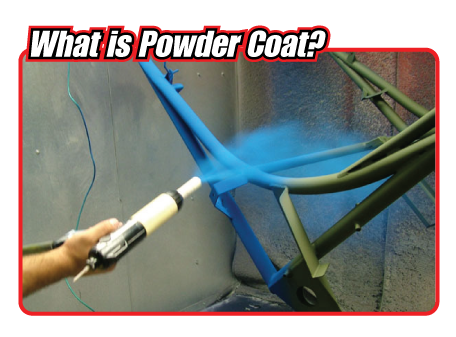
- The Powder Coating Process Involves Three Basic Steps
1. Part preparation or the pre-treatment
2. The powder application
3. Curing
- Part Preparation Processes
- Removal of oil, soil, lubrication greases, metal oxides, welding scales etc. is essential prior to the powder coating process. It can be done by a variety of chemical and mechanical methods. The selection of the method depends on the size and the material of the part to be powder coated, the type of soil to be removed and the performance requirement of the finished product.
Chemical pre-treatments involve the use of phosphates or chromates in submersion or spray application. These often occur in multiple stages and consist of degreasing, etching, de-smutting, various rinses and the final phosphating or chromating of the substrate. The pre-treatment process both cleans and improves bonding of the powder to the metal. Recent additional processes have been developed that avoid the use of chromates, as these can be toxic to the environment. Titanium zirconium and silanes offer similar performance against corrosion and adhesion of the powder.
Another method of preparing the surface prior to coating is known as abrasive blasting or sandblasting, bead blasting, soda blasting and shot blasting. Blast media and blasting abrasives are used to provide surface texturing and preparation, etching, finishing, and degreasing for products made of wood, plastic, or glass. The most important properties to consider are chemical composition and density; particle shape and size; and impact resistance.
Silicon carbide grit blast media is brittle, sharp, and suitable for grinding metals and low-tensile strength, non-metallic materials. Plastic media blast equipment uses plastic abrasives that are sensitive to substrates such as aluminum, but still suitable for de-coating and surface finishing. Sand blast media uses high-purity crystals that have low-metal content. Glass bead blast media contains glass beads of various sizes.
Cast steel shot or steel grit is used to clean and prepare the surface before coating. Shot blasting recycles the media and is environmentally friendly. This method of preparation is highly efficient on steel parts such as I-beams, angles, pipes, tubes and large fabricated pieces.
Different powder coating applications can require alternative methods of preparation such as abrasive blasting prior to coating.
- Powder Application Processes
- The most common way of applying the powder coating to metal objects is to spray the powder using an electrostatic gun, or corona gun. The gun imparts a positive electric charge on the powder, which is then sprayed towards the grounded object by mechanical or compressed air spraying and then accelerated toward the work piece by the powerful electrostatic charge.
There are a wide variety of spray nozzles available for use in electrostatic coating. The object is then heated, and the powder melts into a uniform film, and is then cooled to form a hard coating. It is also common to heat the metal first and spray the powder onto the hot substrate. Preheating can help to achieve a more uniform finish but can also create other problems, such as runs caused by excess powder.
- Curing
- When a thermoset powder is exposed to elevated temperature, it begins to melt, flows out, and then chemically reacts to form a higher molecular weight polymer in a network-like structure. This cure process, called cross linking, requires a certain temperature for a certain length of time in order to reach full cure and establish the full film properties for which the material was designed. Normally the powders cure at 200°C (390°F) for 10 minutes. The curing schedule could vary according to the manufacturer's specifications.
The application of energy to the product to be cured can be accomplished by convection cure ovens or infrared cure ovens.
